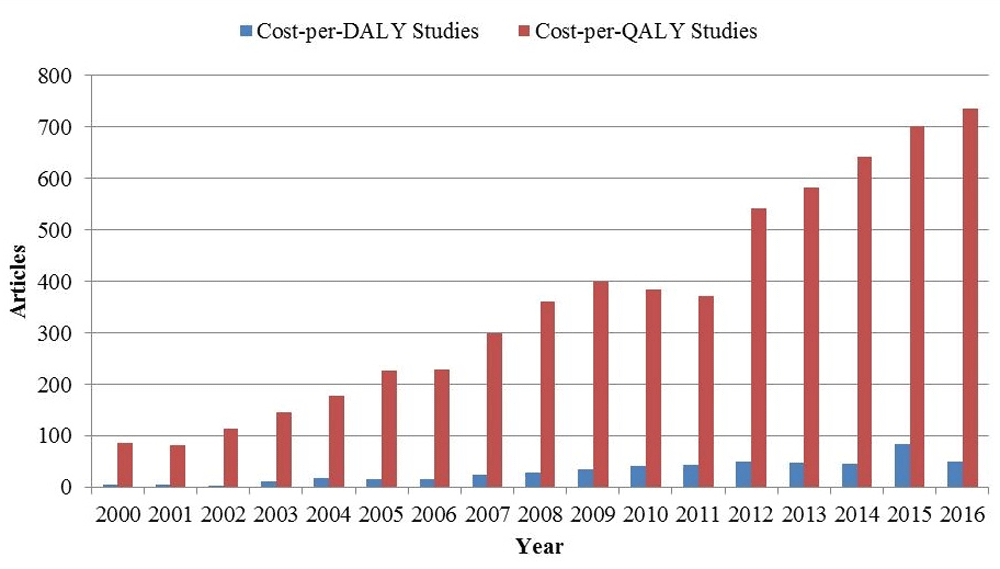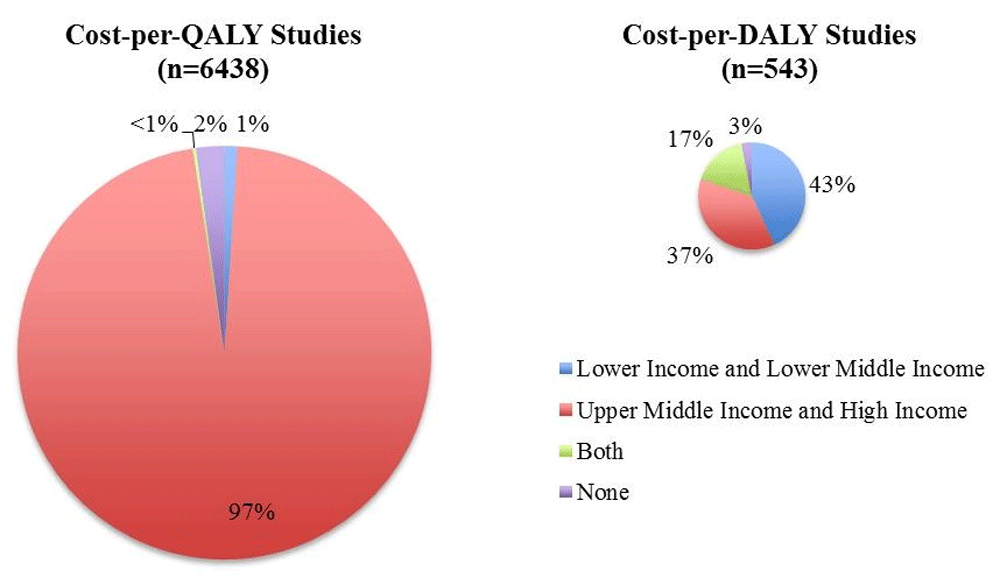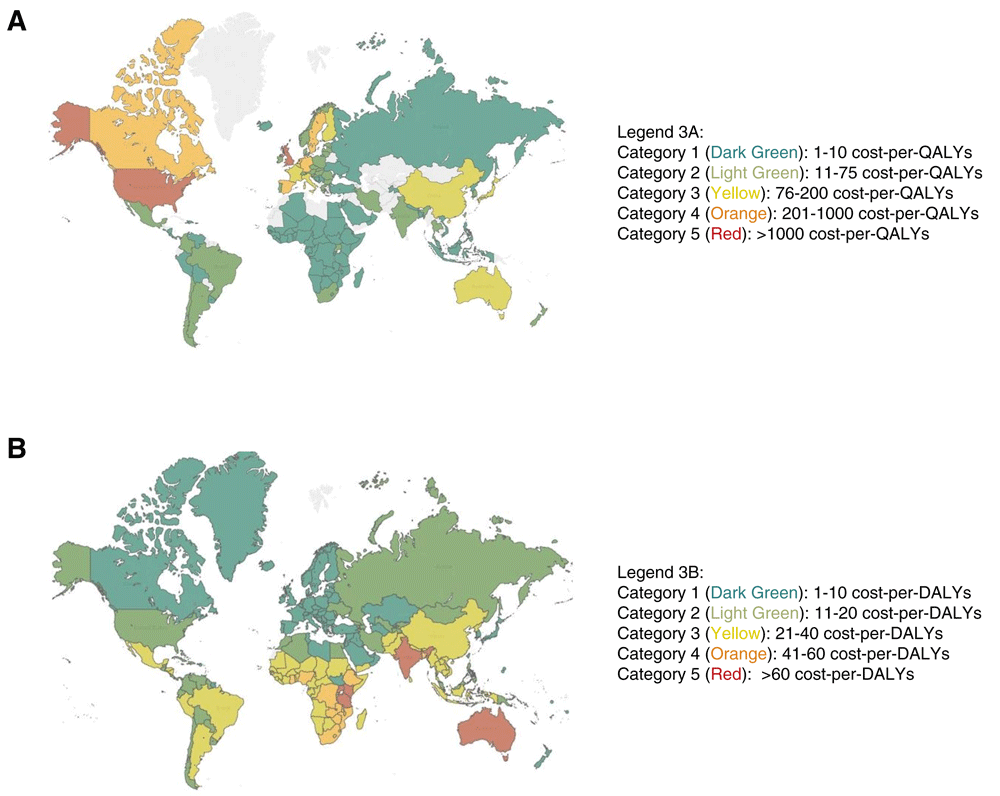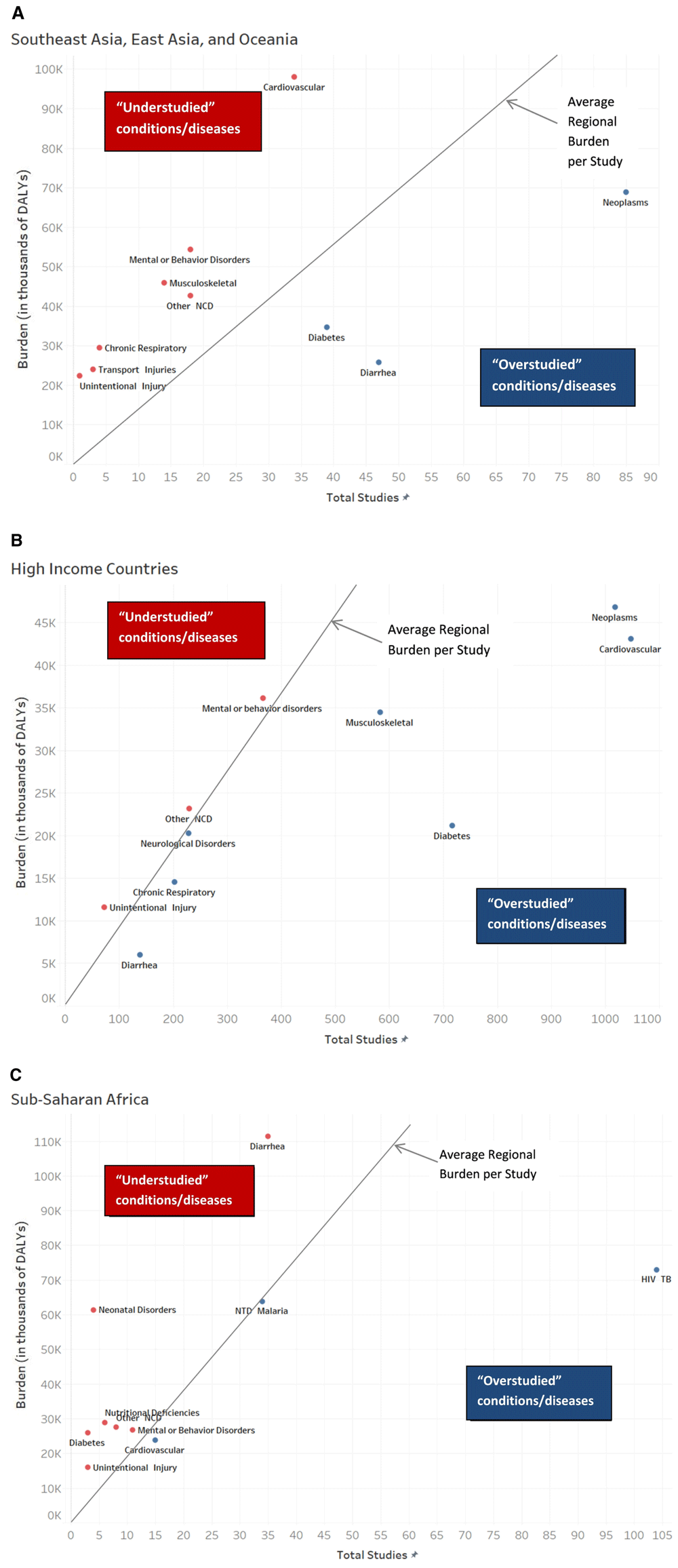Keywords
Quality-adjusted life years, Disability-adjusted life years, Cost-effectiveness
Quality-adjusted life years, Disability-adjusted life years, Cost-effectiveness
Researchers conducting cost-effectiveness analyses (CEAs) commonly use quality-adjusted life years (QALYs) or disability-adjusted life years (DALYs) as health outcome measures to account for both longevity and quality of life (or life with disability)1. These broadly applicable metrics facilitate comparisons across conditions and diseases.
Analysts have used these measures in different contexts and settings2–6. CEAs using the cost-per-QALY metric, which first appeared in the late 1970s, have typically focused on interventions in higher incomes settings7–8. In the 1990s, the World Bank and the World Health Organization (WHO) developed the DALY to quantify disease burden (reflecting both years of life lost (YLL) and years of life with disability (YLD))9–10. CEAs using DALYs have tended to focus on lower- and middle-income countries11.
QALYs and DALYs, which both quantify health related quality of life by assigning a value ranging from zero to one to each year with a health condition, have somewhat different methodological underpinnings12. QALY preference weights range from 0 (corresponding to “dead”) to 1 (corresponding to a hypothetical state of “perfect health”) and reflect a set of health state “attributes”, “dimensions”, or “domains” – e.g., discomfort, mobility, depression, etc. – associated with an individual’s health condition or conditions. DALY weights have a similar intuitive interpretation, although in the case of DALYs, 1 corresponds to “dead” and 0 corresponds to “perfect health. For DALYs, however, each weight corresponds not to a set of health state attributes but to a specific disease13.
DALY calculations have in the past depended on the age of the affected populations. “Age-weighting” reflected the contention that an additional life year accrued during childhood or old age is worth less than a year accrued during young and middle adulthood, when productivity contributions to societal well-being are typically greatest14,15. Because the unequal treatment of different age groups raised substantial ethical concerns, the most recent DALY calculation methods have no age-weighting16.
We analysed the cost-per-QALY gained and cost-per-DALY averted literatures to examine their growth and regional variation, and to analyze the extent to which the focus of each literature corresponded to those diseases and conditions imposing the largest burden on the population.
The cost-effectiveness analysis literature. We analyzed two databases maintained by the Center for the Evaluation of Value and Risk in Health at Tufts Medical Center in Boston, Massachusetts: the Cost-Effectiveness Analysis (CEA) Registry (www.cearegistry.org), which contains information on cost-per-QALY studies, and the Global Health CEA Registry (www.ghcearegistry.org), which houses information on cost-per-DALY studies. Both registries contain information on PubMed-indexed, English-language CEAs published through 2016. Previous publications further detail the search strategies, data collection processes, and review methods, which are similar for both registries5,6. We received ethics exemption for this study because it did not involve human subjects. Data from these registries used in this analysis appear in Dataset 1 and Dataset 2; Supplemental file 1 and Supplemental file 2 contain documentation for the variables in these datasets.
Disease burden. Dataset 3 contains population disease burden estimates (total DALYs incurred) reported by the Institute for Health Metrics and Evaluation (IHME) stratified by Global Burden of Disease (GBD) Super Region17. Within each Super Region, we substratified population burden by GBD level two disease category. Dataset 3 also lists the number of articles from the cost-per-QALY literature and from the cost-per-DALY literature for each of these strata and substrata. Articles focusing on multiple countries could be counted in more than one of the Table 3 strata – e.g., if two countries of focus for a particular study belong to two distinct GBD Super Regions.
Study characteristics. Using data from Dataset 1 and Dataset 2 and definitions from the World Bank and the GBD initiative, we stratified studies by: GBD Super Region, World Bank Income Level, Intervention type, Study Funder category, Prevention stage, and GBD Category. As detailed in Table 1, some of these categories are mutually exclusive, while others are not. We computed the proportion of studies in each stratum using total article counts for the cost-per-QALY and cost-per-DALY literature from Dataset 1 and Dataset 2, respectively.
Countries are classified on 2016 USD into the following categories: low-income (GNI/Capita < $1,005), lower-middle income (GNI $1,006 – $3,955), upper-middle income (GNI $3,956 – $12,235), and high-income (GNI > $12,235)18. GBD Super regions are as reported in the GBD study, 2010.
| Cost-per-QALY studies | Cost-per-DALY studies | Overall | |
|---|---|---|---|
| Number of studies | 6438 | 543 | 6981 |
| GBD Super Region | |||
| High income | 89% | 20% | 84% |
| Southeast Asia, East Asia, and Oceania | 4% | 11% | 5% |
| Sub-Saharan Africa | 1% | 30% | 4% |
| Multiple Regions# | 1% | 16% | 1% |
| Latin America and Caribbean | 1% | 8% | 2% |
| Central Europe, Eastern Europe, and Central Asia | 1% | 2% | 1% |
| South Asia | 0% | 8% | 1% |
| North Africa and Middle East | 1% | 2% | 1% |
| NA | 2% | 3% | 2% |
| World Bank Income Category | |||
| Low-Income and Lower-Middle-Income | 1% | 43% | 4% |
| Upper Middle-Income and High-Income | 97% | 37% | 92% |
| Both | 0% | 17% | 2% |
| None | 2% | 3% | 2% |
| Intervention* | |||
| Pharmaceutical | 44% | 32% | 43% |
| Surgical | 13% | 8% | 13% |
| Screening | 12% | 14% | 12% |
| Care delivery | 11% | 17% | 11% |
| Medical procedure | 12% | 4% | 12% |
| Health education or behavior | 9% | 21% | 10% |
| Immunization | 6% | 27% | 8% |
| Other | 5% | 46% | 22% |
| Study funder* | |||
| Government | 33% | 47% | 34% |
| Pharmaceutical or device company | 29% | 4% | 27% |
| Foundation | 10% | 33% | 11% |
| Healthcare organization^ | 4% | 9% | 5% |
| None/Not determined | 24% | 24% | 24% |
| Other | 8% | 21% | 9% |
| Prevention stage* | |||
| Primary | 15% | 59% | 18% |
| Secondary | 16% | 20% | 16% |
| Tertiary | 62% | 38% | 60% |
| GBD Category | |||
| Neoplasms | 18% | 3% | 17% |
| Cardiovascular and circulatory diseases | 17% | 5% | 16% |
| Diabetes, urogenital, blood, and endocrine diseases | 12% | 5% | 11% |
| Other communicable, maternal, neonatal, and nutritional disorders | 10% | 7% | 9% |
| Musculoskeletal disorders | 10% | 1% | 9% |
| Mental and behavioral disorders | 6% | 7% | 6% |
| HIV/AIDS and tuberculosis | 4% | 20% | 6% |
| Digestive diseases | 4% | 1% | 4% |
| Diarrhea, LRI, and other common infectious diseases | 2% | 20% | 3% |
| Other | 18% | 31% | 19% |
Key: # “Multiple regions” refers to studies that reported cost-effectiveness estimates for countries in different regions.
^ Health care organizations include insurance companies, hospitals, HMOs, WHO.
* Not mutually exclusive
GBD: Global burden of disease
GNI: Gross National Income
HMO: Health maintenance organization
LRI: Lower respiratory infection
WHO: World Health Organization
Based on these counts and proportions, we report the proportion of studies in each stratum (Table 1), number of cost-per-QALY and cost-per-DALY studies published by year (Figure 1), proportion of published CEAs stratified by World Bank country income category and by study type (cost-per-QALY or cost-per-DALY) (Figure 2), and number of cost-per-QALY and cost-per-DALY studies focusing on each country (Figures 3A and 3B).

Journals published 360 cost-per-QALY studies during the years 1976 through 2000. Journals published 13 cost-per-DALY studies during the years 1995 through 2000.

The area of each pie chart is proportional to the number of studies catalogued in each registry.

Number of published cost-per-QALY (3A) and cost-per-DALY (3B) studies by country. The maps present the number of cost-per-QALY and cost-per-DALY studies for each country. Gray countries did not have any studies associated with them. If a study reported a cost-effectiveness estimate for two or more countries, we counted a CEA for each country (e.g. if a study reviewed an intervention in both Canada and the United States, both countries were counted for that study). If a study reported a “global” cost-effectiveness ratio, we excluded it from the counts used to produce this map. We also excluded from these counts studies that did not clearly specify an applicable country or region. (3A) We excluded one study classified as “international”. We excluded 144 studies because the country of study was unclear. (3B) We excluded 13 studies classified as “international”. We excluded 16 studies because the country of study was unclear.
Literature coverage vs. disease burden. We characterized the relationship between the number of CEA studies (cost-per-QALY plus cost-per-DALY) focusing on each disease and corresponding normalized burden for each of three GBD Super Regions: Southeast Asia, East Asia, and Oceania; high-income countries; and Sub-Saharan Africa. We limited attention to the top 10 diseases by total population DALY burden for each of these regions. We computed normalized disease burden as total DALYs attributed to each disease in a Super Region divided by that Super Region’s population. Finally, we identified “under-studied” diseases in each Super Region – i.e., diseases with a normalized burden in excess of the average for other diseases with the same coverage in the literature.
Each figure panel includes a diagonal line that represents the average disease burden as a function of the number of CEA studies (Figures 4A–C). Diseases plotted to the “northwest” of this line are “understudied” within that region because the disease-burden is higher, on average, for that disease than it is for other diseases receiving the same level of attention in the literature.

The figures show the relationship between literature coverge (number of cost-per-QALY plus cost-per-DALY studies) focusing on each disease (horizontal axis) and corresponding normalized disease burden (vertical axis) for each of three GBD Super Regions: (4A) Southeast Asia, East Asia, and Oceana; (4B) high-income countries; and (4C) Sub-Saharan Africa. Each panel displays results for the top 10 diseases by total population DALY burden in that region. Normalized disease burden on the vertical axis is the total number of DALYs attributed to each disease in that panel’s Super Region divided by the Super Region’s population. Each figure panel includes a diagonal line representing average disease burden as a function of literature coverage (total published CEAs). Each disease plotted above this line is “understudied” because its burden is higher, on average, than the corresponding burden for other diseases receiving the same level literature coverage.
We identified 6,438 cost-per-QALY (Dataset 1) and 543 cost-per-DALY (Dataset 2) studies published up to 2016. The number of published studies in the cost-per-QALY and cost-per-DALY literatures has increased steadily since 2000 (Figure 1).
Cost-per-QALY studies have tended to focus on upper-middle income and high-income countries (97%); e.g. United States has 2,321 and United Kingdom 1,149. Cost-per-DALY studies have focused to a much greater extent on low and lower-middle income countries (43%); e.g. India has 95, China has 51, and Uganda has 90 (Table 1, Figure 2, Figure 3A and 3B).
Tertiary prevention (treatment) dominated the cost-per-QALY registry (e.g. pharmaceuticals, 44%; surgery, 13%), whereas the cost-per-DALY registry focused far more on primary prevention (e.g. immunizations, 27%). Conditions most frequently addressed by studies in the cost-per-QALY literature included non-communicable diseases, such as cancer (18%) and cardiovascular diseases (17%), whereas most cost-per-DALY registry studies targeted infectious diseases.
Non-governmental cost-per-DALY study funding came most often from foundations (33%), while cost-per-QALY study funding derived most often from pharmaceutical or device companies (29%).
Neoplasms were the most studied diseases in Southeast Asia, East Asia, and Oceania (Figure 4A), while mental and behavioral disorders were less studied relative to their burden. High-income countries (Figure 4B) had relatively few studies addressing mental and behavioral disorders, and injuries. Relative to burden, HIV/AIDS and tuberculosis were the most studied diseases in Sub-Saharan Africa, while this region reported fewer studies on nutritional deficiencies (Figure 4C).
Our review reveals a notable increase in the publication of cost-per-QALY and cost-per-DALY studies since 2000, thus making ever more cost-effectiveness information available to aid decision makers in their efforts to prioritize resources. The literature spans a wide range of interventions, diseases, and geographic regions.
The data demonstrate key differences between the cost-per-QALY and cost-per-DALY literatures (Table 1). The cost-per-QALY literature focuses on high-income countries, while cost-per-DALY studies focus more on lower- and middle-income income nations. This contrast seems to reflect the historic proclivities of health economist researchers, rather than any inherent advantages for one metric’s use for a particular category of countries. The differences extend to the types of interventions and diseases represented: cost-per-QALY studies tend to address diseases of wealthier countries (e.g., cardiovascular disease and cancer), while cost-per-DALY studies address diseases more prevalent in low-income countries (e.g., infectious diseases, such as tuberculosis and HIV). The two literatures also differ in terms of the interventions on which they focus. More cost-per-QALY studies evaluate pharmaceuticals, while cost-per-DALY studies focus more often on immunizations.
The most commonly studied diseases, regions, and interventions may reflect the financial interests of the CEA funders. For instance, pharmaceutical companies invest in pharmaceutical CEAs in high-income countries.
Our data also indicate discrepancies between literature coverage and burden of disease. These analyses suggest that some diseases and conditions (e.g., cardiovascular disease and mental health in Southeast Asia, South Asia and Oceania) are “understudied,” while other diseases and conditions (e.g., HIV in Sub-Saharan Africa) are “overstudied”. These discrepencies may represent opportunities for the re-direction of CEA research funding in the future.
We have made the data used in this analysis available through the Open Science Foundation (OSF): http://doi.org/10.17605/OSF.IO/3BEK519.
License: CC0 1.0 Universal.
Dataset 1. Cost-per-QALY dataset.
Includes the cost-per-QALY data used in this paper.
Dataset 2. Cost-per-DALY dataset.
Includes the cost-per-QALY data used in this paper.
Dataset 3. Regional and disease level stratification dataset.
Includes disease burden and literature coverage data used in this paper.
Supplementary File 1. Cost-per-QALY manual. Documents the variables collected in the cost-per-QALY database.
Click here to access the data.
Supplementary File 2. Cost-per-DALY manual. Documents the variables collected in the cost-per-DALY database.
All authors have completed the Unified Competing Interest form and declare; a grant from the Bill and Melinda Gates Foundation for the submitted work; no financial relationships with any organizations that might have interest in the submitted work in the previous three years, no other relationships or activities that could appear to have influenced the submitted work.
Bill and Melinda Gates Foundation [OPP1171680].
The funders had no role in study design, data collection and analysis, decision to publish, or preparation of the manuscript.
| Views | Downloads | |
|---|---|---|
| Gates Open Research | - | - |
|
PubMed Central
Data from PMC are received and updated monthly.
|
- | - |
Is the work clearly and accurately presented and does it cite the current literature?
Yes
Is the study design appropriate and is the work technically sound?
Yes
Are sufficient details of methods and analysis provided to allow replication by others?
Yes
If applicable, is the statistical analysis and its interpretation appropriate?
Yes
Are all the source data underlying the results available to ensure full reproducibility?
Yes
Are the conclusions drawn adequately supported by the results?
Yes
Competing Interests: No competing interests were disclosed.
Reviewer Expertise: Non-communicable disease economic evaluation
Is the work clearly and accurately presented and does it cite the current literature?
Partly
Is the study design appropriate and is the work technically sound?
Yes
Are sufficient details of methods and analysis provided to allow replication by others?
Yes
If applicable, is the statistical analysis and its interpretation appropriate?
Yes
Are all the source data underlying the results available to ensure full reproducibility?
Yes
Are the conclusions drawn adequately supported by the results?
Partly
References
1. Santatiwongchai B, Chantarastapornchit V, Wilkinson T, Thiboonboon K, et al.: Methodological variation in economic evaluations conducted in low- and middle-income countries: information for reference case development.PLoS One. 2015; 10 (5): e0123853 PubMed Abstract | Publisher Full TextCompeting Interests: No competing interests were disclosed.
Is the work clearly and accurately presented and does it cite the current literature?
Yes
Is the study design appropriate and is the work technically sound?
Yes
Are sufficient details of methods and analysis provided to allow replication by others?
Partly
If applicable, is the statistical analysis and its interpretation appropriate?
I cannot comment. A qualified statistician is required.
Are all the source data underlying the results available to ensure full reproducibility?
Yes
Are the conclusions drawn adequately supported by the results?
Yes
References
1. Airoldi M, Morton A: Adjusting life for quality or disability: stylistic difference or substantial dispute?. Health Econ. 2009; 18 (11): 1237-47 PubMed Abstract | Publisher Full TextCompeting Interests: No competing interests were disclosed.
Alongside their report, reviewers assign a status to the article:
| Invited Reviewers | |||
|---|---|---|---|
| 1 | 2 | 3 | |
|
Version 2 (revision) 05 Mar 18 |
|||
|
Version 1 18 Jan 18 |
read | read | read |
Provide sufficient details of any financial or non-financial competing interests to enable users to assess whether your comments might lead a reasonable person to question your impartiality. Consider the following examples, but note that this is not an exhaustive list:
Sign up for content alerts and receive a weekly or monthly email with all newly published articles
Register with Gates Open Research
Already registered? Sign in
If you are a previous or current Gates grant holder, sign up for information about developments, publishing and publications from Gates Open Research.
We'll keep you updated on any major new updates to Gates Open Research
The email address should be the one you originally registered with F1000.
You registered with F1000 via Google, so we cannot reset your password.
To sign in, please click here.
If you still need help with your Google account password, please click here.
You registered with F1000 via Facebook, so we cannot reset your password.
To sign in, please click here.
If you still need help with your Facebook account password, please click here.
If your email address is registered with us, we will email you instructions to reset your password.
If you think you should have received this email but it has not arrived, please check your spam filters and/or contact for further assistance.
Comments on this article Comments (0)